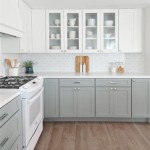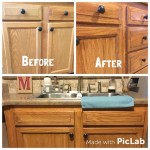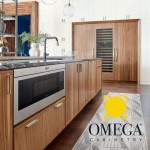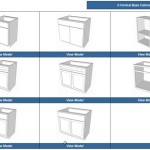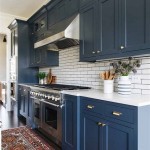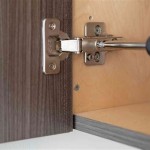Kitchen Floor Ideas With Gray Cabinets
Gray cabinets have become a staple in modern kitchen design due to their versatility and ability to complement a wide range of styles. However, selecting the ideal flooring to pair with gray cabinets requires careful consideration of several factors, including the desired aesthetic, durability, and maintenance requirements. The following explores various kitchen flooring options that can harmoniously blend with gray cabinetry, creating a visually appealing and functional space.
Understanding the Undertones of Gray Cabinets
The success of pairing flooring with gray cabinets hinges on understanding the specific undertones present in the cabinet color. Gray is not a monolithic shade; it can lean towards warm (beige, brown) or cool (blue, green) undertones. Identifying these undertones is crucial for selecting a flooring material that complements rather than clashes with the cabinetry.
For example, gray cabinets with warm undertones benefit from flooring options that echo this warmth. Natural wood tones, such as oak or maple, introduce a sense of organic warmth and complement the subtle beige or brown within the gray. Conversely, cooler grays pair well with flooring options that have cooler undertones themselves, such as slate tile or certain shades of vinyl.
Neutral grays, lacking distinct warm or cool undertones, offer the most flexibility. These cabinets can serve as a blank canvas, allowing for a wider range of flooring choices. However, even with neutral grays, considering the overall lighting and surrounding elements is vital to ensure a cohesive design.
Popular Flooring Materials and Their Compatibility with Gray Cabinets
Several flooring materials are commonly used in kitchens, each offering distinct advantages and aesthetic properties. This section explores how each material interacts with gray cabinetry.
Hardwood: Hardwood flooring is a classic choice that adds warmth and sophistication to any kitchen. When paired with gray cabinets, the wood's natural grain and color variations create a visually appealing contrast. Lighter wood tones, such as white oak or maple, can brighten the space and prevent it from feeling too dark, especially when combined with darker gray cabinets. Darker wood tones, like walnut or cherry, create a more dramatic and luxurious feel. The finish of the hardwood is also important. A matte finish provides a more natural and understated look, while a glossy finish adds a touch of formality and reflects more light. However, hardwood is susceptible to water damage and requires regular maintenance, making it less ideal for kitchens prone to spills and moisture.
Tile: Tile is a durable and water-resistant flooring option that is well-suited for kitchens. Porcelain and ceramic tiles are available in a vast array of colors, patterns, and sizes, allowing for extensive design flexibility. When pairing tile with gray cabinets, consider the overall style of the kitchen. For a modern aesthetic, large-format tiles with a smooth, matte finish can create a seamless and contemporary look. For a more traditional kitchen, smaller tiles in intricate patterns, such as herringbone or basketweave, can add visual interest. Neutral-toned tiles, such as white, beige, or light gray, can create a bright and airy feel, while darker tiles, such as slate or charcoal gray, can add depth and drama. Textured tiles can also add tactile interest and prevent slippage.
Vinyl: Vinyl flooring has evolved significantly in recent years, offering realistic wood and stone looks with enhanced durability and water resistance. Luxury vinyl plank (LVP) and luxury vinyl tile (LVT) are particularly popular choices for kitchens due to their ease of installation and maintenance. When paired with gray cabinets, vinyl flooring can mimic the look of hardwood or tile at a fraction of the cost. Choose light-colored vinyl floors to brighten the kitchen, especially with dark gray cabinets. Vinyl allows for a wider range of patterns and colors that may not be available within natural hardwood or tile options.
Laminate: Laminate flooring offers a cost-effective alternative to hardwood and tile, with realistic wood and stone patterns printed on a high-density fiberboard core. Laminate is durable and easy to clean, making it a practical choice for busy kitchens. When paired with gray cabinets, laminate flooring can provide a similar aesthetic to hardwood at a lower price point. However, laminate is less water-resistant than vinyl or tile, so it is important to choose a water-resistant laminate specifically designed for kitchens. Like vinyl, lighter shades of laminate tend to pair well with darker gray cabinets, which can help to brighten smaller spaces.
Concrete: Concrete flooring offers a modern and industrial aesthetic that can complement gray cabinets. Polished concrete floors are durable and easy to maintain, and they can be stained or sealed in a variety of colors. When paired with gray cabinets, concrete floors create a sleek and minimalist look. The natural variations in the concrete add visual interest, while the smooth surface is easy to clean. Concrete floors can be cold underfoot, so consider adding radiant heating for added comfort. The neutral color of concrete also grants flexibility in cabinetry color as well.
Key Considerations for Choosing the Right Flooring
Beyond the aesthetics, practical considerations play a crucial role in selecting the ideal flooring for a kitchen with gray cabinets. These considerations include durability, maintenance, cost, and installation.
Durability and Maintenance: Kitchen floors are subject to heavy foot traffic, spills, and potential impacts from dropped objects. Therefore, durability is a paramount concern. Tile, concrete, and high-quality vinyl are highly durable options that can withstand the rigors of a busy kitchen. Hardwood and laminate are less durable and may require more frequent maintenance. Consider the lifestyle and usage patterns of the household when assessing durability requirements. For example, homes with pets or young children may benefit from more resilient flooring options.
Maintenance is another important factor to consider. Some flooring materials, such as tile and vinyl, are easy to clean with simple soap and water. Hardwood requires more specialized cleaning products and care to prevent water damage. Concrete floors may require periodic sealing to maintain their impermeability. Evaluate the time and effort required to maintain each flooring option and choose one that aligns with the homeowner's preferences and capabilities.
Cost and Installation: The cost of flooring can vary significantly depending on the material, brand, and installation complexity. Hardwood and high-end tile are typically the most expensive options, while laminate and vinyl offer more budget-friendly alternatives. Installation costs can also vary depending on the size and complexity of the kitchen, as well as the chosen flooring material. Some flooring options, such as vinyl plank, can be installed as a DIY project, while others, such as tile and hardwood, typically require professional installation.
Consider the overall budget for the kitchen renovation or remodel when selecting flooring. Obtain quotes from multiple contractors to compare prices and ensure that the installation is performed correctly. Remember to factor in the cost of underlayment, adhesives, and other necessary supplies.
Lighting and Space: Lighting conditions and the size of the kitchen space significantly impact the overall look and feel of the room. In small kitchens or kitchens with limited natural light, lighter flooring options can help to brighten the space and create a more open and airy feel. Darker flooring options can make a small kitchen feel even smaller and more enclosed. Conversely, in large kitchens with ample natural light, darker flooring options can add depth and drama.
Artificial lighting can also affect the appearance of flooring. Warm-toned lighting can enhance the warmth of wood floors, while cool-toned lighting can accentuate the coolness of tile or concrete floors. Consider the existing lighting fixtures and the overall ambiance of the kitchen when selecting flooring.
Reflective surfaces, such as glossy tile or polished concrete, can bounce light around the room and make it feel brighter. Matte finishes absorb light and create a more subdued and cozy atmosphere. Choose a flooring finish that complements the lighting conditions and the desired aesthetic for the kitchen.
In conclusion, selecting the right flooring to complement gray cabinets involves careful consideration of aesthetic preferences, practical requirements, and budget constraints. By understanding the undertones of the gray cabinets, exploring various flooring materials, and accounting for durability, maintenance, cost, and lighting conditions, homeowners can create a kitchen that is both visually appealing and functionally sound.

10 Insta Worthy Kitchen Flooring Ideas With Gray Cabinets Hunker Slate Floor Small Layouts

Home Design It S A Process Here An Example Grey Kitchen Floor Wood Cabinets

Contemporary Kitchen With Light Gray Cabinets Wood Floors And White Textured Backsplash Floor Cabinet Design Grey Kitchens

44 Gray Kitchen Cabinets Dark Or Heavy Light Modern

Great Gray Kitchen Ideas When Redesigning Your Home Aco

20 Gray Kitchen Cabinets We Re Loving
:max_bytes(150000):strip_icc()/407cd98dbf9f90fff35b7c0d805963bf33d02d6a-5b343de846e0fb005b753272.jpeg?strip=all)
20 Ways To Style Gray Kitchen Cabinets

6 Design Ideas For Gray Kitchen Cabinets

Top Kitchen Remodeling Trends For 2024 Latest Grey Floor Cabinets Flooring

2024 Kitchen Cabinet Trends 20 Ideas Flooring Inc
Related Posts


